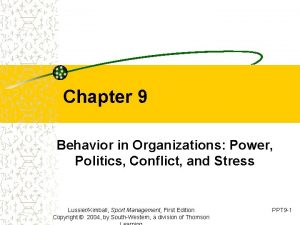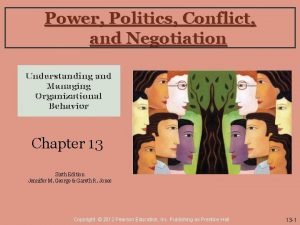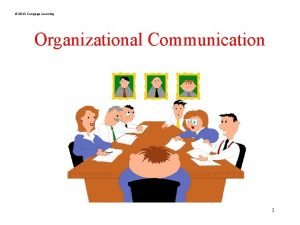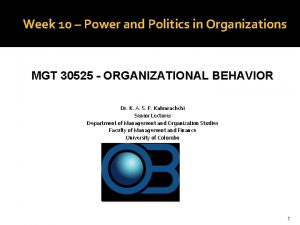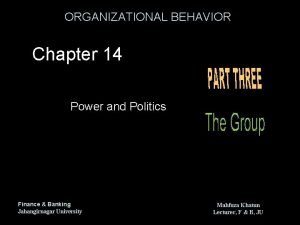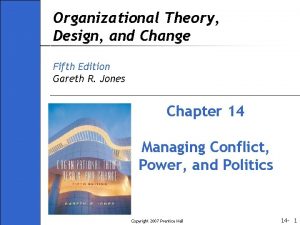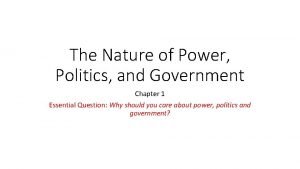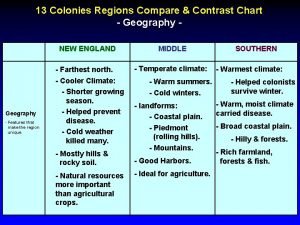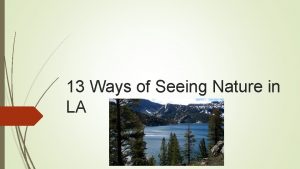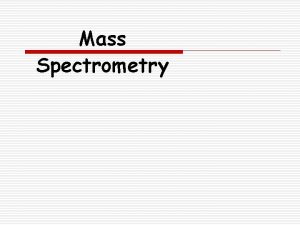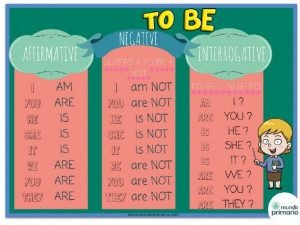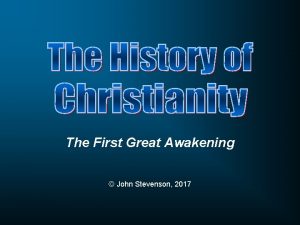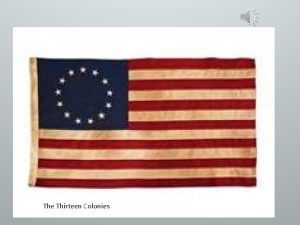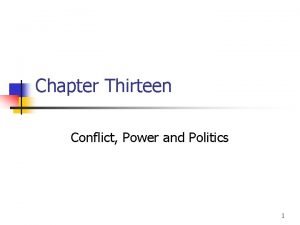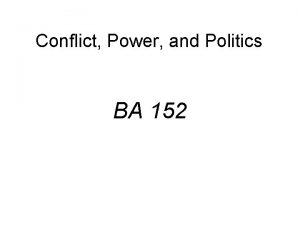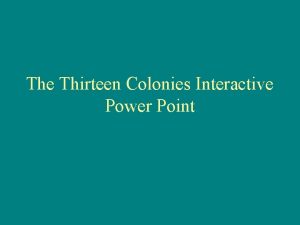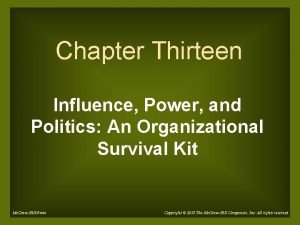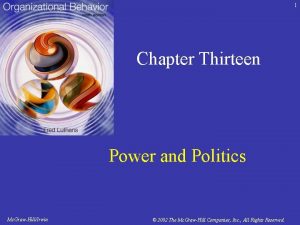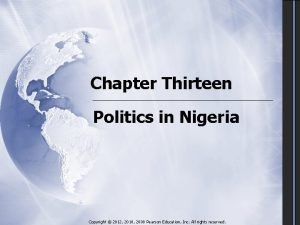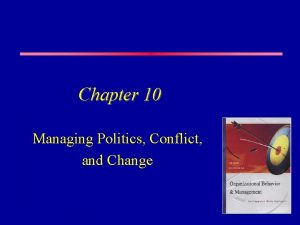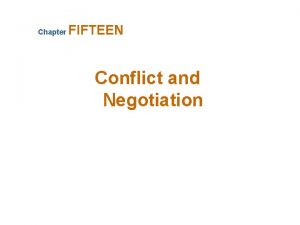Chapter Thirteen Conflict Power and Politics 2010 Cengage
















- Slides: 16

Chapter Thirteen Conflict, Power, and Politics © 2010 Cengage Learning. All Rights Reserved. May not be scanned, copied or duplicated, or posted to a publicly accessible website, in whole or in part.

Intergroup Conflict in Organizations • • Groups may be dispersed across the organization Intergroup conflict requires three ingredients: 1. Group Identification 2. Observable Group Differences 3. Frustration Conflict is similar to competition but more severe © 2010 Cengage Learning. All Rights Reserved. May not be scanned, copied or duplicated, or posted to a publicly accessible website, in whole or in part. 2

Sources of Conflict ü Goal Incompatibility ü Differentiation ü Task Interdependence ü Limited Resources © 2010 Cengage Learning. All Rights Reserved. May not be scanned, copied or duplicated, or posted to a publicly accessible website, in whole or in part. 3

Sources of Conflict and Use of Rational Versus Political Model © 2010 Cengage Learning. All Rights Reserved. May not be scanned, copied or duplicated, or posted to a publicly accessible website, in whole or in part. 4

Power and Organizations • Power is the potential ability of one person to influence other people • Individual versus Organizational Power – Legitimate Power – Reward Power – Coercive Power – Expert Power – Referent Power © 2010 Cengage Learning. All Rights Reserved. May not be scanned, copied or duplicated, or posted to a publicly accessible website, in whole or in part. 5

Power versus Authority is more narrow than power – Defined by the formal hierarchy and reporting relationships 1) Authority is vested in organizational positions 2) Authority is accepted by subordinates 3) Authority flows down the vertical hierarchy • Power can be exercised upward, downward and horizontally • Authority is exercised downward along the hierarchy © 2010 Cengage Learning. All Rights Reserved. May not be scanned, copied or duplicated, or posted to a publicly accessible website, in whole or in part. 6

Vertical Sources of Power • Formal Position – legitimate power accrued to top positions • Resources – resources can be used as a tool for power • Control of Decision Premises and information – constraints placed on decisions – Control of information can also be a source of power • Network Centrality – being centrally located in the organization and having access • People – loyal executives/managers © 2010 Cengage Learning. All Rights Reserved. May not be scanned, copied or duplicated, or posted to a publicly accessible website, in whole or in part. 7

Information Flow for Computer Decision at Clark Ltd. © 2010 Cengage Learning. All Rights Reserved. May not be scanned, copied or duplicated, or posted to a publicly accessible website, in whole or in part. 8

Illustration of Network Centrality © 2010 Cengage Learning. All Rights Reserved. May not be scanned, copied or duplicated, or posted to a publicly accessible website, in whole or in part. 9

The Power of Empowerment • Power sharing, the delegation of power or authority to subordinates • Empowerment benefits: – Employees receive information about company performance – Employees have knowledge and skills to contribute to company goals – Employees have the power to make substantive decisions © 2010 Cengage Learning. All Rights Reserved. May not be scanned, copied or duplicated, or posted to a publicly accessible website, in whole or in part. 10

Horizontal Sources of Power • Relationships across departments, divisions, units • Strategic Contingencies – groups most responsible for key organization issues • Power Sources – five power sources that departments may possess © 2010 Cengage Learning. All Rights Reserved. May not be scanned, copied or duplicated, or posted to a publicly accessible website, in whole or in part. 11

Strategic Contingencies That Influence Horizontal Power among Departments © 2010 Cengage Learning. All Rights Reserved. May not be scanned, copied or duplicated, or posted to a publicly accessible website, in whole or in part. 12

Political Processes in Organizations • Politics is the use of power to influence decisions toward goals • Organizational Politics - activities to acquire, develop, and use power to influence goals • Domains of political activity: – Structural Change – Management Succession – Resource Allocation © 2010 Cengage Learning. All Rights Reserved. May not be scanned, copied or duplicated, or posted to a publicly accessible website, in whole or in part. 13

Power and Political Tactics in Organizations © 2010 Cengage Learning. All Rights Reserved. May not be scanned, copied or duplicated, or posted to a publicly accessible website, in whole or in part. 14

Negotiating Strategies © 2010 Cengage Learning. All Rights Reserved. May not be scanned, copied or duplicated, or posted to a publicly accessible website, in whole or in part. 15

Design Essentials ü Conflict, power, and politics are natural outcomes of organizing ü There are two views for organizations: rational and political models ü There are vertical and horizontal sources of power ü Certain characteristics make some departments more powerful than others ü Managers need political skills ü Managers should enhance collaboration to reduce conflict © 2010 Cengage Learning. All Rights Reserved. May not be scanned, copied or duplicated, or posted to a publicly accessible website, in whole or in part. 16
 Power, politics and conflict in organizations
Power, politics and conflict in organizations Conflict power and politics
Conflict power and politics 2010 cengage learning
2010 cengage learning Power and politics in organizations
Power and politics in organizations Contrasting leadership and power
Contrasting leadership and power Power and politics organization theory
Power and politics organization theory Power and politics
Power and politics The nature of power politics and government
The nature of power politics and government 13 colonies compare and contrast chart
13 colonies compare and contrast chart Power political
Power political Real power and reactive power
Real power and reactive power Original thirteen colonies
Original thirteen colonies Eleven twelve thirteen fourteen fifteen
Eleven twelve thirteen fourteen fifteen 13 ways of seeing nature in la
13 ways of seeing nature in la Rule of thirteen mass spectrometry
Rule of thirteen mass spectrometry Freddy the thirteen
Freddy the thirteen Thirteen colonies
Thirteen colonies
